MARIANI’S
Virtual Gourmet
May 7,
2017
NEWSLETTER

Still Life by Paolo Antonio Barbieri (c. 1640)
❖❖❖
IN THIS ISSUE
OAXACA
By Joanna Pruess
NEW YORK CORNER
TAVERN 62 By David Burke
By John Mariani
NOTES FROM THE WINE CELLAR
HOW TO KNOW WHEN A WINE'S GONE BAD
By John Mariani
❖❖❖
OAXACA
By Joanna Pruess

A
trip to Oaxaca had been on my bucket
list for so long that my kids refused to let me
mention the Mexican destination ever again. “Just
do it,” they implored. When I recently got
there—no surprise—this UNESCO World Heritage
Site’s archeological treasures, colorful arts and
crafts, and celebrated cuisine 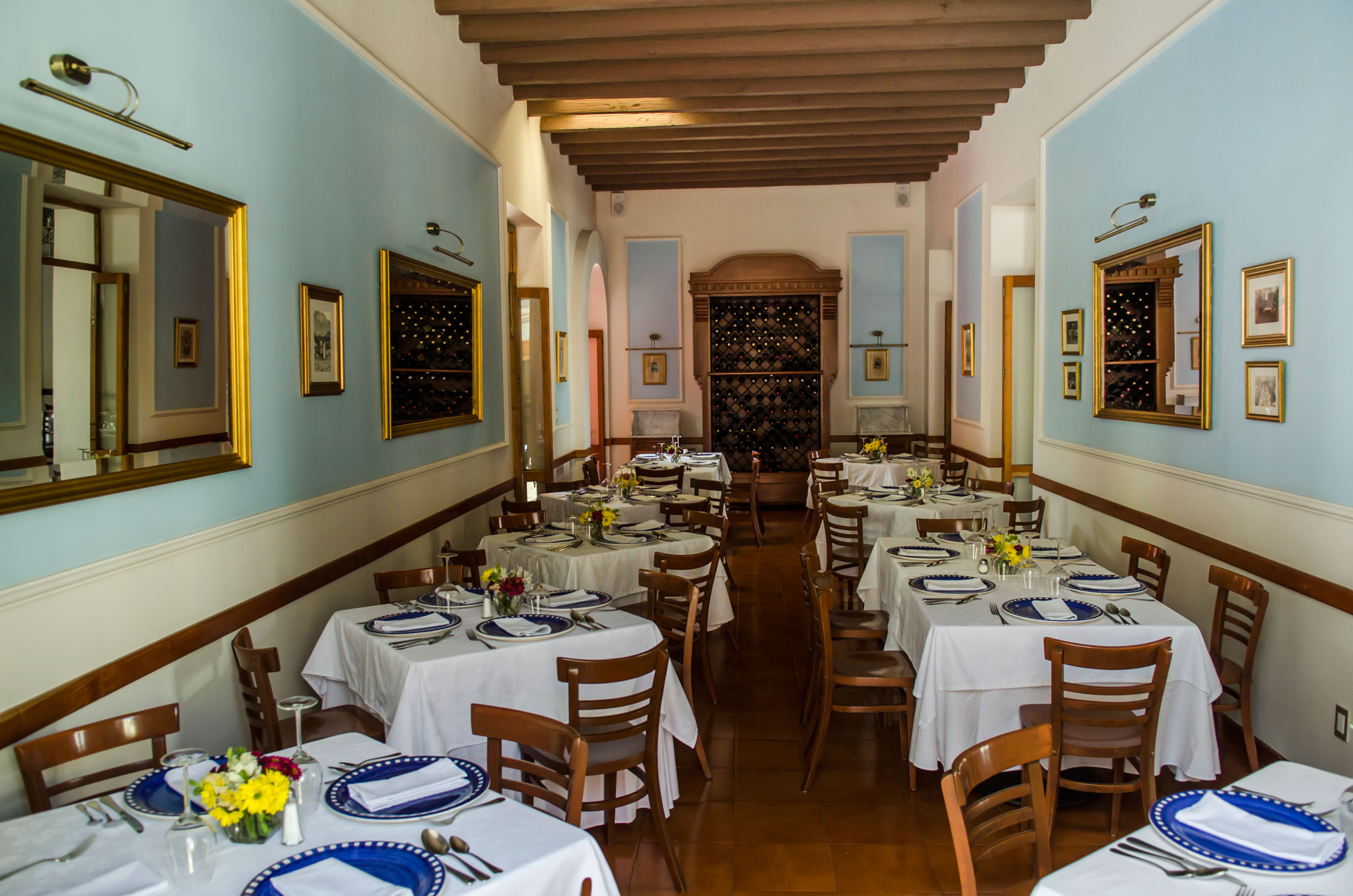 far exceeded my
expectations.
far exceeded my
expectations.
As the co-author of three Mexican cookbooks
with chef Ivy Stark, I already loved certain Oaxacan
specialties, especially moles, the
labor-intensive mixtures of roasted and ground
chiles, nuts, spices, seeds and dried fruits that
are the foundation of many local dishes. In Mexican
Spanish, mole
comes from the Nahuatl word mōlli and means “sauce,”
as well as the dishes based on them. Technically
there are seven Oaxacan moles. In
reality, however, every cook, family and region
makes unique variations.
Americans are most familiar with the spicy
chocolate chile-based mole negro. In
Oaxaca, that smooth, dark sauce is reserved for
turkey or chicken. Traditionally, each mole is
used with specific proteins, says Edgardo Aguilar,
an owner and general manager of the elegant Restaurante Catedral
(right),
where his mother has prepared classic Oaxacan food
for 40 years. He offered me several mole dishes
to illustrate.
 One of my
favorites, the lesser-known manchamanteles,
is usually served with pork. The name means
“tablecloth stainer” (left) for the red spots the
mixture inevitably leaves wherever it falls.
Ingredients for the spicy-sweet sauce usually
include tomatoes, ancho chiles and cinnamon, plus
roasted pineapple and plantains. The succulent pork
fillet I ate also included sweet potato and apple.
Aguilar added that it’s considered essential to
serve plenty of warm tortillas with mole
dishes.
One of my
favorites, the lesser-known manchamanteles,
is usually served with pork. The name means
“tablecloth stainer” (left) for the red spots the
mixture inevitably leaves wherever it falls.
Ingredients for the spicy-sweet sauce usually
include tomatoes, ancho chiles and cinnamon, plus
roasted pineapple and plantains. The succulent pork
fillet I ate also included sweet potato and apple.
Aguilar added that it’s considered essential to
serve plenty of warm tortillas with mole
dishes.
To learn about making moles and
other regional specialties, I visited Susana
Trilling’s Seasons of My Heart Cooking School .
Trilling owned restaurants in New York and New
Zealand before opening her school outside Oaxaca in
1988. The hands-on classes are taught in a colorful
open kitchen apart from her home on a gorgeous
hilltop setting. She also takes students to local
markets where the well-known TV personality and
author has a personal relationship 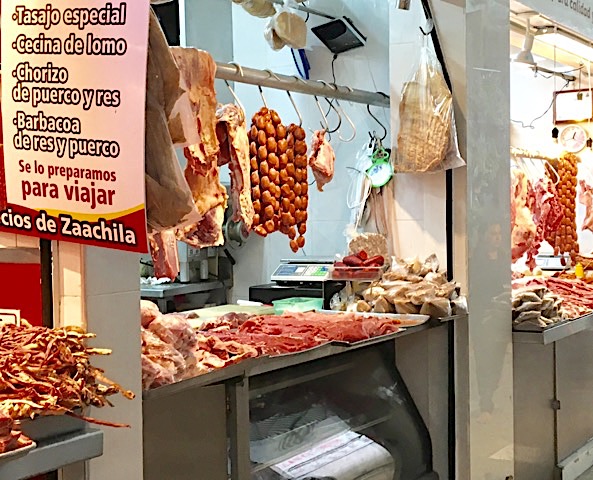 with the vendors.
with the vendors.
For a
good sample of Oaxacan food and culture, wander
around the Zócalo, the town’s central square, with
its bustling sidewalk cafés fronting two-story
Colonial buildings. While wandering the city, admire
monuments like the baroque Temple of Santo Domingo,
with its gold leaf-encrusted altar, and explore the
lively pedestrian streets crammed with eateries and
boutiques.
Be sure to check out the nearby el Mercado de
20 de Noviembre, where among the piles of
colorful produce and chiles are basketsful of chapulines (fried
grasshoppers), a local delicacy best downed with a
shot of mescal.
Carnivores should visit el Pasillo de
las Carnes Asadas, the smoky aisle where
dozens of meat stands offer
chile-coated pork, beef and sausages to be
grilled over hot coals. It’s a no-frills affair:
choose your meat and grab a seat. Once the meat is
cooked, it’s brought to you on paper plates. Buy
tortillas and condiments like pickled onions,
guacamole, or salsa, along with a soft drink or
water, and you’re in for an earthy feast.
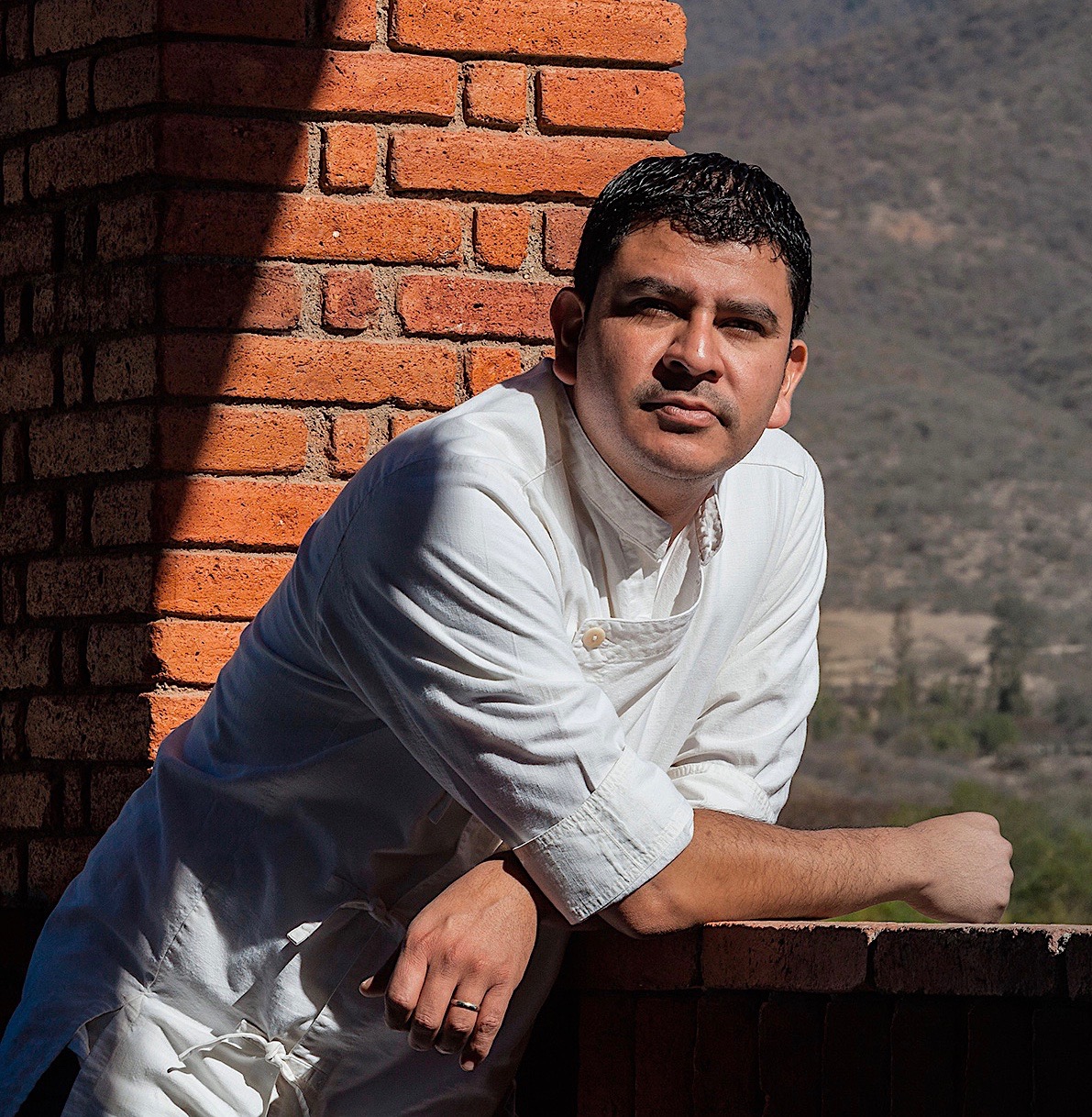 While
Oaxacans respect tradition, some chefs are creating
modern interpretations based on time-honored
fundamentals. At the casually refined Restaurant
Origen, as the name implies, chef Rodolfo
Castellanos’s food is inspired by the culture,
customs and traditions of his family, especially
those of his mother, Evelia Reyes.
While
Oaxacans respect tradition, some chefs are creating
modern interpretations based on time-honored
fundamentals. At the casually refined Restaurant
Origen, as the name implies, chef Rodolfo
Castellanos’s food is inspired by the culture,
customs and traditions of his family, especially
those of his mother, Evelia Reyes.
While growing up, Castellanos (left) worked in
his parents’ take-out food business 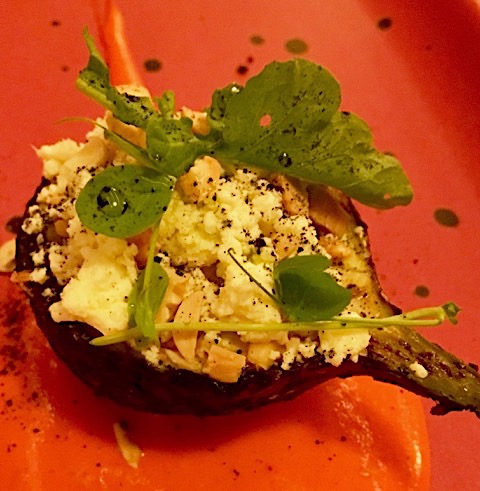 before attending culinary school, then
returned to Oaxaca to open Origen to explore a
universe of flavors. The kitchen’s seasonal and
local ingredients are sourced from the central
Oaxacan valleys of his youth and from regions around
the state like Sierra Sur, Mixteca and Istmo.
before attending culinary school, then
returned to Oaxaca to open Origen to explore a
universe of flavors. The kitchen’s seasonal and
local ingredients are sourced from the central
Oaxacan valleys of his youth and from regions around
the state like Sierra Sur, Mixteca and Istmo.
His background is reflected in the colors and
in the bold, delicious flavors of a roasted
butternut squash filled with bell peppers, almonds
and arugula, served with a bright red pepper sauce (right). Two
notable main courses showcased traditional
ingredients. A butterflied grilled fish was painted
with chintextle,
a stoneground paste made with smoked pasilla de
Oaxaca chilies, herbs and garlic. The
condiment, milled by indigenous people in southern
Mexico for generations, added a rich taste to the
dish, which was served with chickpeas and amaranth
greens. Confit of suckling pig with manchamantel
mole were perfect partners. Only later did I
learn that the garnish was powdered chicatana,
ant eggs.
 Origen’s
five-course pairing menu included a shot glass of
the ubiquitous mezcal, followed by an original
cocktail, a craft beer and wines, all of which
worked in concert with the food.
Origen’s
five-course pairing menu included a shot glass of
the ubiquitous mezcal, followed by an original
cocktail, a craft beer and wines, all of which
worked in concert with the food.
Another chef, the
renowned Alejandro Ruíz, has served sophisticated
interpretations of local specialties for about 20
years. I met him by chance when a friend and I
stopped in at one of his two Casa Oaxaca
restaurants, among the most popular places to eat in
town. Ruíz’s cooking style is called “criollo,”
a term that refers to food made with traditional
ingredients and techniques from across the region.
In spite of his fame, the chef (below) was
gracious and humble, in keeping with his childhood
on the dairy farm where he was raised. He suggested
we eat at his just-opened Oaxacalifornia
(left),
a fish-centric  restaurant
that fuses Oaxacan and Baja California specialties.
Our reward was Ensenada-style fish tacos; shrimp
with tempura of pitiona, a local herb, and passion
fruit salsa; and an incredibly tender octopus that
was first braised then grilled, perhaps the best I’d
ever eaten. As a finale, we swooned over his plate
of ice cream and sauce in which the flavor of
Oaxaca’s celebrated chocolate was front and center.
restaurant
that fuses Oaxacan and Baja California specialties.
Our reward was Ensenada-style fish tacos; shrimp
with tempura of pitiona, a local herb, and passion
fruit salsa; and an incredibly tender octopus that
was first braised then grilled, perhaps the best I’d
ever eaten. As a finale, we swooned over his plate
of ice cream and sauce in which the flavor of
Oaxaca’s celebrated chocolate was front and center.
Beyond food, the crafts and folk art were
equally extraordinary and similarly based on
traditions. Linda Hanna, who organizes the Oaxacan
contingent of artists for the annual Mexican folk
art show, Féria
Maestro del Arte, in Chapala, served as my
guide to the crafts produced in the area. A transplanted
Californian, Linda came to visit Oaxaca 20 years ago
and never left. 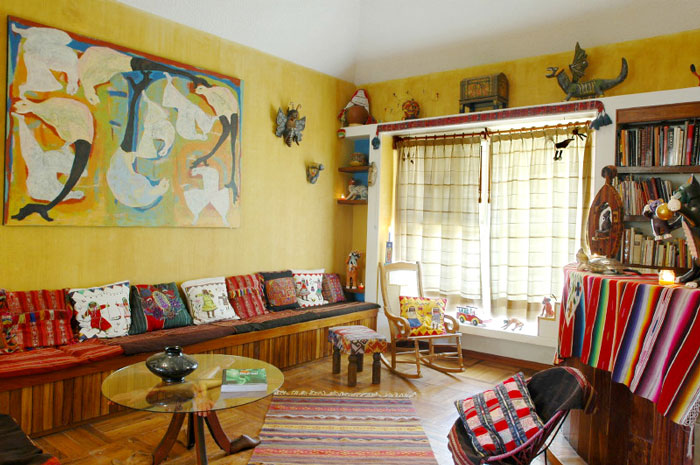 Her
enchanting B&B, Casa Linda (left), five miles outside of town,
is a low-slung floor-to-ceiling showcase for a
variety of local artisans, including weavers,
woodworkers, ceramists, tin workers and painters.
Her
enchanting B&B, Casa Linda (left), five miles outside of town,
is a low-slung floor-to-ceiling showcase for a
variety of local artisans, including weavers,
woodworkers, ceramists, tin workers and painters.
There are three comfortable double bedrooms:
two in the house and a third in a private casita on
the property, each with a private bathroom. She
usually offers a fairly ample breakfast of eggs and
sometimes tamales before starting a tour. Walking
through the house, Linda asked what kinds of crafts
I liked to better guide my tour. My first choices
were ceramics, weavers, and wood carvers.
As
we drove up and down the bumpy roads to explore some
craft-focused towns, Linda shared her extensive
knowledge of the traditions and arts that are the
hallmarks of each form. She explained that
every village specialized in a particular craft. For
example, both utilitarian and decorative ceramic
work is done in at least three different pueblos:
San Bartolo Coyotepec, Ocotlan de Morelos, and
Atzompa.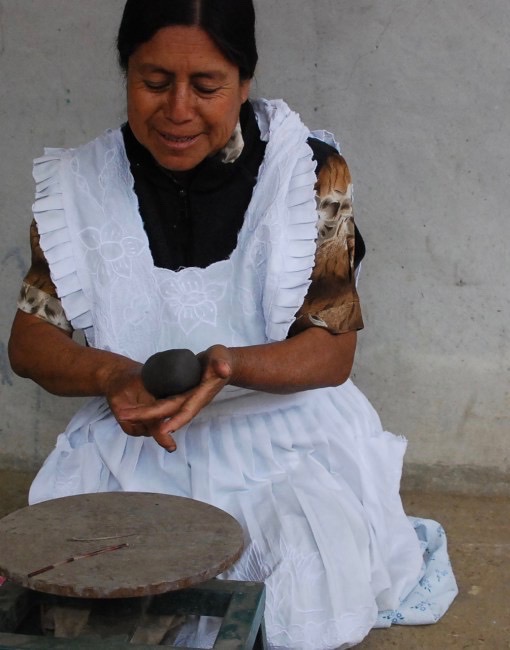
In
Santa María Atzompa we visited Irma Blanco (right), daughter of the
famous Teodora Blanco Núñez, both known for muñecas, or
female figures, nativity scenes, fanciful tree of
life sculptures, angels and mermaids. I watched as
her nimble fingers created charming figurines in
about 15 minutes. Larger projects can take over a
week.
We visited weavers in Santa Tomás Jalieza,
where a dark rose-hued striped purse caught my eye,
and Mitla, where my beautiful rebozo, or
shawl, had been woven of special cotton from
Chiapas. My next craft acquisition will hopefully be
a hand-carved alebrije
figure, the brightly painted animals with bold
Zapotec-inspired designs, like those made by Jacobo
and Maria Angeles in San Martin Tilcajete.
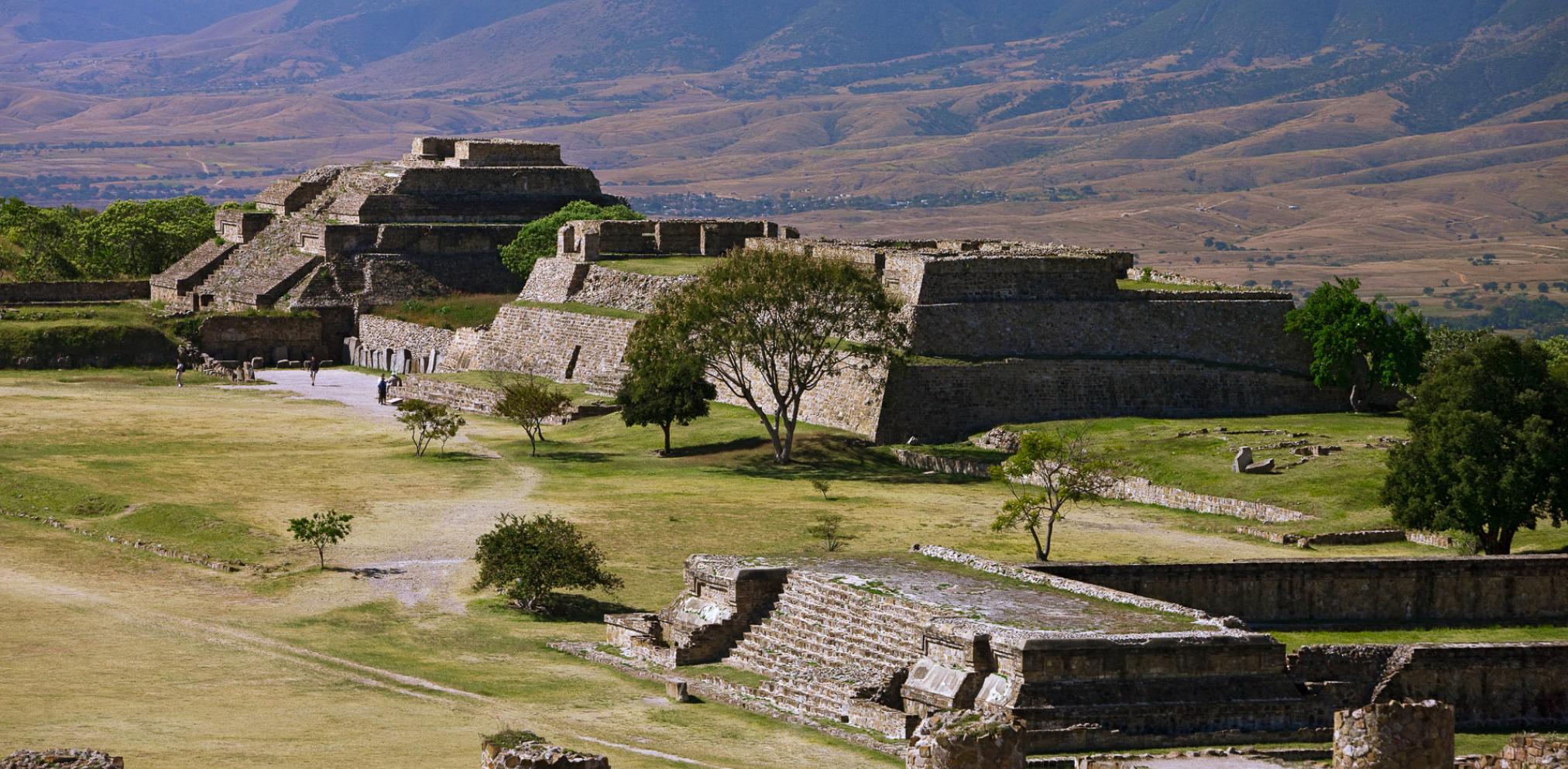 To get a perspective of
the region’s rich history, Linda drove me to the
ruins of Monte
Alban (left),
one of Oaxaca’s must-see sights, a 45-minute drive
from the city. The expansive Zapotec capital, dating
from 500 BC to 800 AD, sits atop a flat mountain
with broad panoramas of the valleys below. Among the
wonders to be found at the vast early Mesoamerican
urban center were the remarkably vibrant and
contemporary-looking depictions of people in
animated positions, called “Los Danzantes,”
etched onto stele-like stones, and the astronomical
observatory, where ancient people made scientific
discoveries that hold true today.
To get a perspective of
the region’s rich history, Linda drove me to the
ruins of Monte
Alban (left),
one of Oaxaca’s must-see sights, a 45-minute drive
from the city. The expansive Zapotec capital, dating
from 500 BC to 800 AD, sits atop a flat mountain
with broad panoramas of the valleys below. Among the
wonders to be found at the vast early Mesoamerican
urban center were the remarkably vibrant and
contemporary-looking depictions of people in
animated positions, called “Los Danzantes,”
etched onto stele-like stones, and the astronomical
observatory, where ancient people made scientific
discoveries that hold true today. 
For
more historic insights, I visited the Museo de la
Culturas de Oaxaca, attached to the Temple of
Santo Domingo, a restored Dominican monastery that
houses collections of important archeological and
historical relics, especially Mixtec treasures from
tomb seven at Monte Albán. Other museums I was able
to visit included the Ruffino
Tamayo Pre-Hispanic Art Museum, Museo Textil de
Oaxaca for textiles, and MUFI: the
stamp museum.
After achieving my dream of visiting Oaxaca, I left
feeling sad that my short trip didn’t allow me to
more fully discover this glorious place and its
friendly people.
Accommodations:
Hotel Azul is a quiet, well-placed, stylish boutique hotel set around a courtyard that is within easy walking distances of Oaxaca’s sites and restaurants. The staff is extremely attentive. Breakfast is included with the room.
By John Mariani
Photos by Mikey Pozarik
and courtesy of Tavern 62

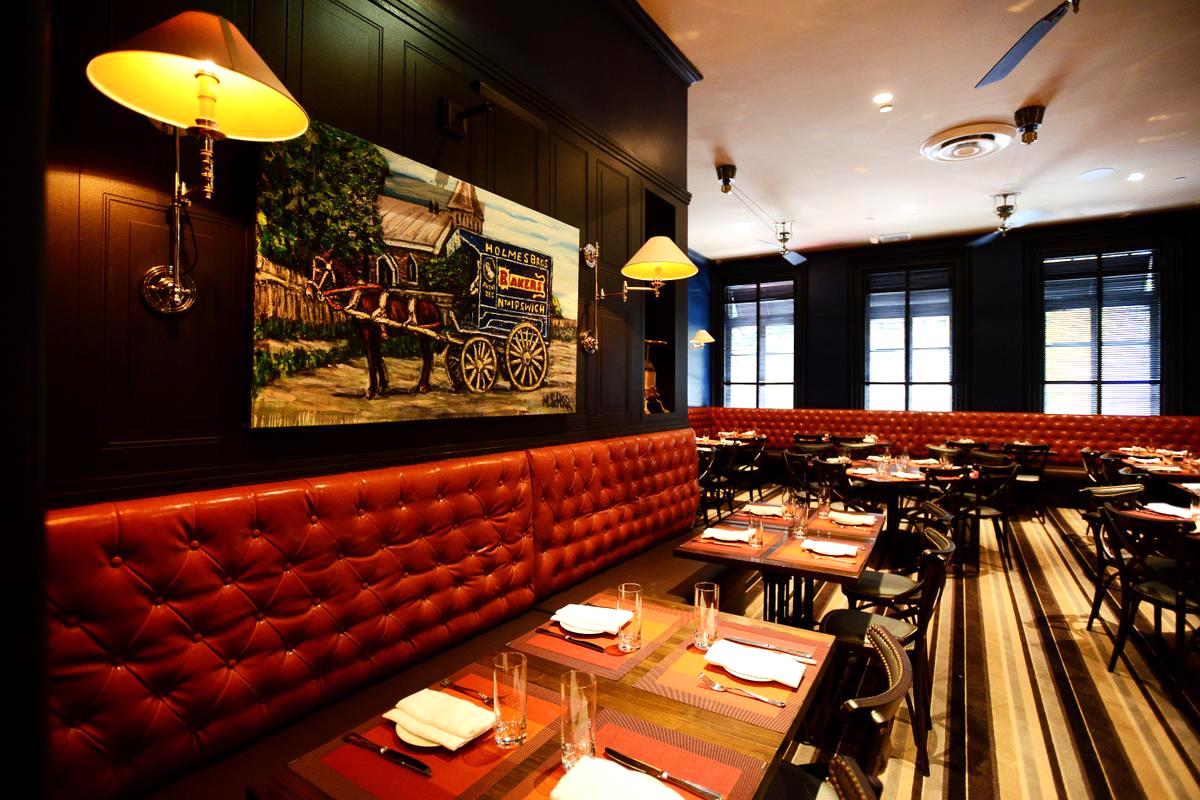
135 E 62nd Street (near
Lexington Avenue)
212- 988-9021
For 25 years now David
Burke has been a highly respected fixture of
NYC’s restaurant scene, sometimes riding high,
sometimes scrambling. Born and raised in New
Jersey, Burke (below)
worked with some of the best chefs in France,
where he won the
coveted Meilleurs Ouvriers de France Diplôme
d’Honneur at the International Culinary
Competition, the only American to achieve that
honor.
In the U.S., he distinguished
himself at the age of 26 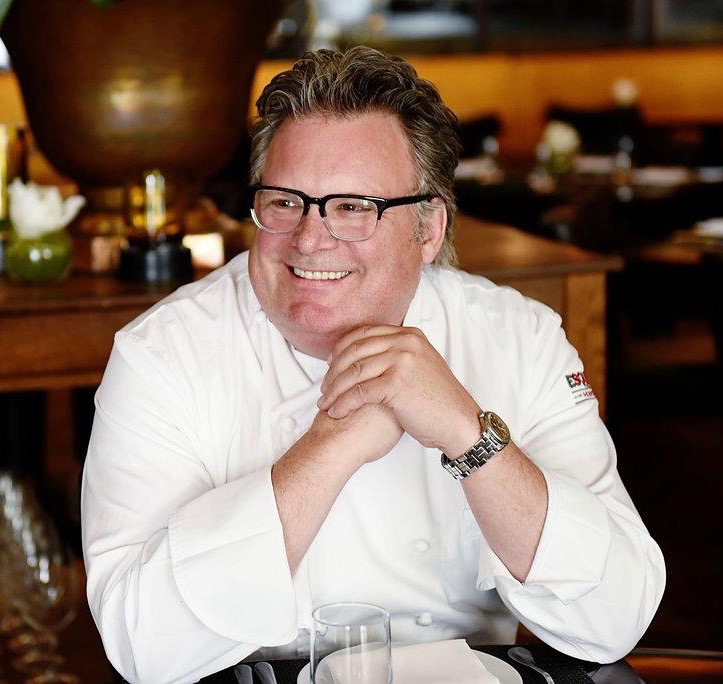 upon
taking over at Brooklyn’s River Café through
1992. He then capitalized on his rising rep by
putting his name on many restaurants, including david burke townhouse,
David Burke at Bloomingdale’s, Fishtail by David
Burke and David Burke Kitchen, all in NYC, and
David Burke’s Primehouse in Chicago. Cookbooks
were written,
and he appeared on TV’s “Top Chef
Masters” and “Iron Chef.” For
various reasons several of the restaurants with
his name on them closed, and last year he became
branded under the
restaurant group ESquared, best known for
its BLT chain.
Photo by Susan
Mazzullo
upon
taking over at Brooklyn’s River Café through
1992. He then capitalized on his rising rep by
putting his name on many restaurants, including david burke townhouse,
David Burke at Bloomingdale’s, Fishtail by David
Burke and David Burke Kitchen, all in NYC, and
David Burke’s Primehouse in Chicago. Cookbooks
were written,
and he appeared on TV’s “Top Chef
Masters” and “Iron Chef.” For
various reasons several of the restaurants with
his name on them closed, and last year he became
branded under the
restaurant group ESquared, best known for
its BLT chain.
Photo by Susan
Mazzullo
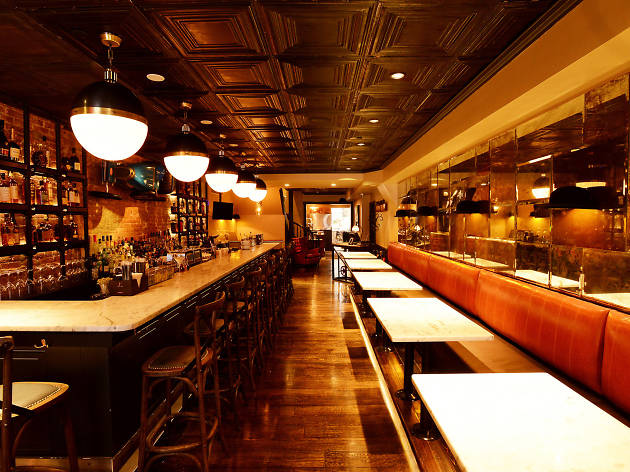 Tavern
62 is the newest iteration of this lovely
townhouse space on East 62nd Street (previously
Fishtail by David Burke), and there’s good reason
to think this one will have a long run. It’s a
smart-looking place, keeping the handsome
downstairs bar (left)
and reconfiguring the main upstairs dining room (above) in
vivid colors, with red banquettes, dark brown
walls, sconces and fine striped carpeting; sadly,
tablecloths are absent, so the current noise level
(which Burke told me they’re working on) blunts
civilized conversation, requiring instead that
guests add to the din by raising their voices
several notches.
Tavern
62 is the newest iteration of this lovely
townhouse space on East 62nd Street (previously
Fishtail by David Burke), and there’s good reason
to think this one will have a long run. It’s a
smart-looking place, keeping the handsome
downstairs bar (left)
and reconfiguring the main upstairs dining room (above) in
vivid colors, with red banquettes, dark brown
walls, sconces and fine striped carpeting; sadly,
tablecloths are absent, so the current noise level
(which Burke told me they’re working on) blunts
civilized conversation, requiring instead that
guests add to the din by raising their voices
several notches.
The menu shows the solidity of
the Burke repertoire, with several dishes that
long had a place in other venues, not least the
clothesline of candied bacon (below) with
maple, black pepper and sour pickle ($18), which
tastes every bit as good as it looks. I
suppose the easiest moniker I can apply to Burke’s
current cooking would be Contemporary American,
meaning the menu has a global reach, from
excellent dishes like wheatgrass noodles 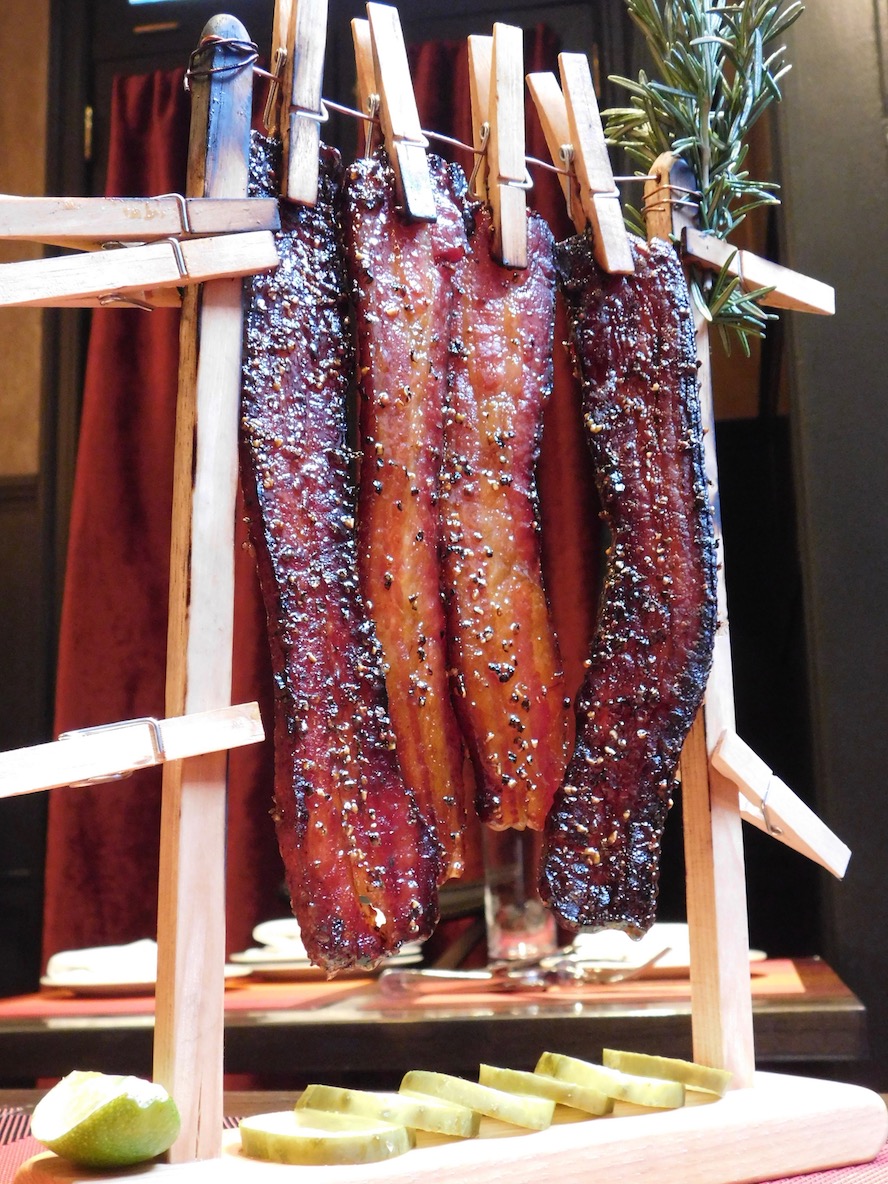 with ten vegetables,
Parmesan and black pepper ($16/$28) to a fabulous
dish of huge flavors—Peking pork shank with plum
sauce, crȇpes, shrimp and lap chong fried rice
($36), although the crȇpes were brittle when they
should have been moist (below).
with ten vegetables,
Parmesan and black pepper ($16/$28) to a fabulous
dish of huge flavors—Peking pork shank with plum
sauce, crȇpes, shrimp and lap chong fried rice
($36), although the crȇpes were brittle when they
should have been moist (below).
As a starter Burke’s salmon
pastrami is a winning, signature item, placed atop
gaufrette potato
chips. Pretzel-crusted
crab cakes ($18) look little like the crabcake
most people would expect, but the inclusion of
greens within the crust is pretty and tasty as
well. “Angry lobster dumplings” with spicy tomato,
lemon confit and basil ($21) missed by being
wrapped in gummy steamed dough.
Among the meat entrees, “Duck,
Duck, Duck” ($38) is a hearty masterpiece of fat
breast, duck foie gras dumpling and a juicy meat
loaf on the platter, and, knowing Burke's’
long-time devotion to the best meat money can
buy—he once had his own breed of steer working for
him—the Prime NY sirloin ($45) was first-rate and
perfectly cooked.
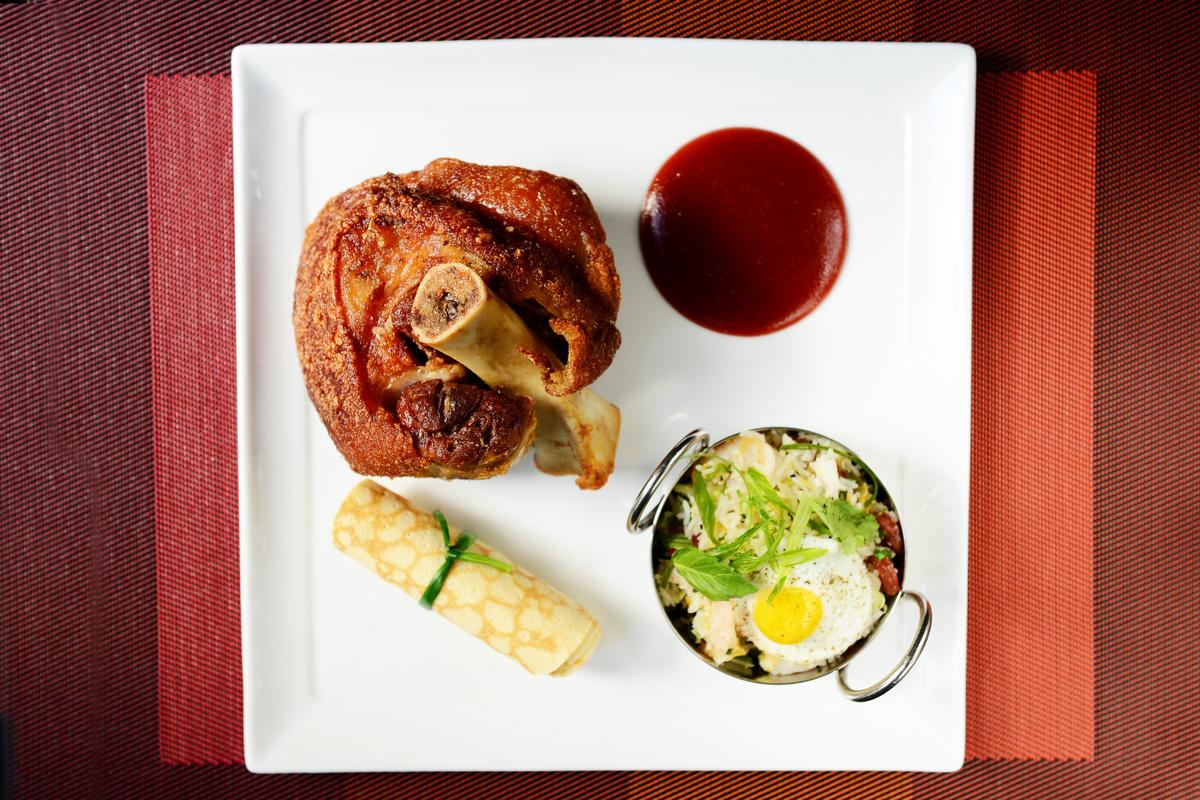 There
are five seafood dishes. The sea scallops with
grilled zucchini, baby leeks and sweet-and-sour
rhubarb ($39) was the stand-out, owing largely to
the quality of the scallops and the balance of the
other ingredients in seasoning and texture.
Everything at a Burke restaurant is going to be
generous, and you’ll likely take some food home
with you.
There
are five seafood dishes. The sea scallops with
grilled zucchini, baby leeks and sweet-and-sour
rhubarb ($39) was the stand-out, owing largely to
the quality of the scallops and the balance of the
other ingredients in seasoning and texture.
Everything at a Burke restaurant is going to be
generous, and you’ll likely take some food home
with you.
“David Burke’s Lollipop tree”
($18)—most certainly a dessert suited for a table
of two to four—comes with raspberry bubblegum
whipped cream. The coconut banana cream pie with a
rich dulce de leche sauce ($12) needs an upgrade;
it’s ... O.K.
The one-page wine list is more
than adequate and the offerings very well
selected, though mark-ups are high: a Ponzi Pinot
Gris 2014 you can buy at the store for $15 runs
$65, and a $55 Nicolas Jay Pinot Noir 2014 at
retail will cost you $155.
David Burke is a chef who’s
seen it all, the comings and goings of fads and
trends, the flash-in-the-pan cooks and the
overhyped shabby eateries in distant zip codes. Burke’s
restaurants have always had heart, the money shows
in the décor and on the plate, and the staff is
never less than professional in every respect. This,
his newest, is one of his best efforts, honed in
on what people really want to
eat rather than simply try.
Open for lunch and dinner daily.
❖❖❖
HOW TO KNOW WHEN A WINE'S GONE BAD

By John Mariani
It happens far more than it
should. I am at a wine tasting or dinner with a
winemaker, I taste a wine and it is clearly off. Smells
funky. Doesn’t smell like much of anything.
Hasn’t any semblance to the varietal on the
label. A white wine the color of bourbon. A red
wine both murky and brown. Bad wines.
 The odd
thing is, while I don’t think my olfactory
receptors are superior to others’, the obvious
nastiness of some of these wines had seemingly
gone unnoticed by the people pouring them. Just
weeks ago a wine poured by a prominent California
winemaker was clearly corked (more on what that
means later), and I, trying to be diplomatic,
said, “It has an odd bouquet.” Only
after being so informed did the fellow who made
the wine say, “Oh, yes, it is corked.”
The odd
thing is, while I don’t think my olfactory
receptors are superior to others’, the obvious
nastiness of some of these wines had seemingly
gone unnoticed by the people pouring them. Just
weeks ago a wine poured by a prominent California
winemaker was clearly corked (more on what that
means later), and I, trying to be diplomatic,
said, “It has an odd bouquet.” Only
after being so informed did the fellow who made
the wine say, “Oh, yes, it is corked.”
On another occasion, while
dining with an editor-in-chief of a major food and
wine magazine, I could see from its color and from
a stench coming from the glass that the Burgundy
had been wholly oxidized. Yet the
editor took a slug and pronounced it marvelous. Again,
trying to be discreet, I noted the wine’s smell of
rotten eggs and the color of a rusted can (left). “Ah,
yes,” said the editor, “Now that I taste it, the
thing is a
bit over the hill.”
Worst incident of all was many
years ago when Sicilian winemakers brought an
array of their wines to New York for the wine
media to taste, and every single one was oxidized.
When their host—himself a Sicilian—told them that
obvious fact, the winemakers bristled, contending,
“This is how we’ve been making our wines for a
thousand years.” Which is exactly what they tasted
like. (Fortunately, the Sicilians have caught up
with the rest of the world of viniculture and now
make excellent modern wines.)
Such
incidents have always baffled me, although I’m
aware that picking up the smell and taste of cork
or oxidation is always a matter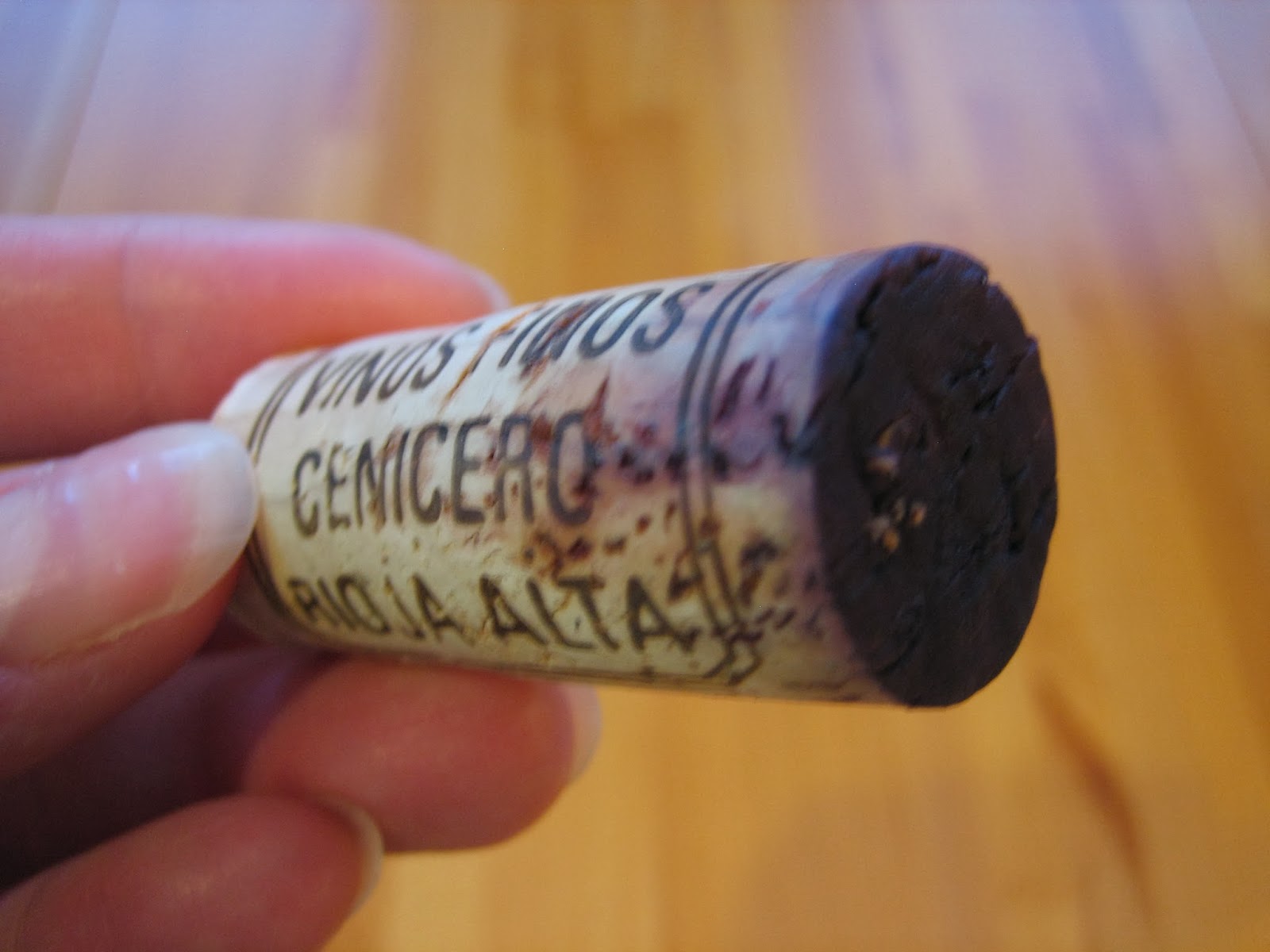 of degree. My wife
has a much better nose for detecting corkiness,
and everyone has a different level of recognition. But
when you smell it, you will always know it. A
corked wine smells, well, like cork, sometimes
rotted cork, and is found in at least 5% of
wines—some winemakers say up to 15%—even if the
stopper was not cork. The taint can also come from
storage of the wines, sanitation, or even the
cardboard boxes in the winery.
of degree. My wife
has a much better nose for detecting corkiness,
and everyone has a different level of recognition. But
when you smell it, you will always know it. A
corked wine smells, well, like cork, sometimes
rotted cork, and is found in at least 5% of
wines—some winemakers say up to 15%—even if the
stopper was not cork. The taint can also come from
storage of the wines, sanitation, or even the
cardboard boxes in the winery.
The chief cause of
cork taint is the presence of the chemical
compounds 2,4,6-trichloroanisole (TCA)
or 2,4,6-tribromoanisole (TBA), usually
transferred from a cork stopper that has been
treated with chlorinated phenolic compounds as
an antimicrobe agent. TCA is measured in parts
per trillion but can still be detected by the
human nose.
Cork producers,
usually from Portugal, insist new processes have
cut down on taint, but the jury is still out among
winemakers and scientists. (At another time I’ll
consider alternatives to corks and why they are
still used at all.)
More obvious to our sense of
smell is oxidation or maderization. The
former is caused by the interaction of the wine
with oxygen, which is always present during
fermentation, but aging in casks can produce the
smell of something burnt or rubbery. Maderization
is similar, but may be caused by heat or poor
storage, making the wine taste like bad Sherry or
Madeira, from which the word derives. Deliberate
maderization is, however, part of the charm of
Sherry, Madeira and Marsala, but, when there is
too much, the wine is unappealing or worse.
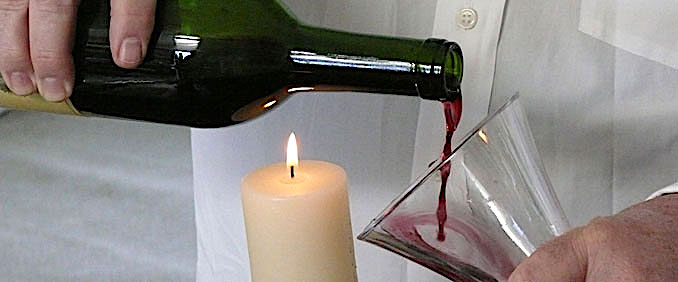 Ironically, as with those
Sicilians who insisted their wines should taste
oxidized, the wine producers of Burgundy used to
praise their wines for smelling like cat urine,
which we now recognize as a very unappealing flaw.
Ironically, as with those
Sicilians who insisted their wines should taste
oxidized, the wine producers of Burgundy used to
praise their wines for smelling like cat urine,
which we now recognize as a very unappealing flaw.
Sediment in older red wines is
mostly dead yeast cells that settle to the bottom
of the bottle. Filtration and clarification can
help alleviate the condition, but the sediment
does not harm the wine’s flavor, unless it is
shaken up throughout the wine. Which
is why, with older vintages, sommeliers decant the
bottles (left). Decanting
a red wine from a two-year-old vintage is
unnecessary and mere showiness.
What about those white crystals
in white wine?
Those are tartrates (right), formed during
fermentation and aging. They are almost always 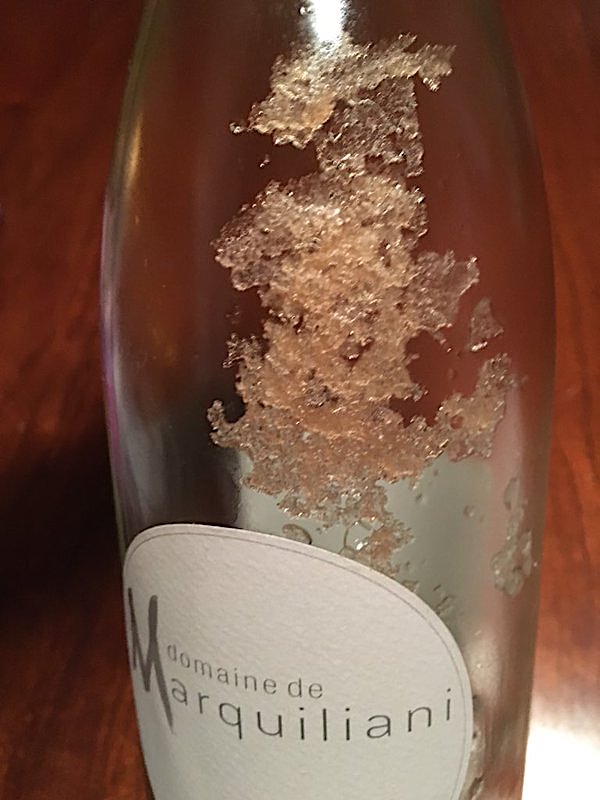 harmless and tasteless, just not
very attractive.
harmless and tasteless, just not
very attractive.
Last, there is what is called a
“dumb period,” when a wine that is perfectly sound
and tasted just great six months ago suddenly
tastes flat, lacking any complexity or fruit. The
science behind why this happens—sometimes called
“bottle shock”—is not conclusive but seems to
suggest that transporting wine can sometimes cause
the condition.
Others suggest that just-bottled wines need
to adjust to being agitated during bottling,
packaging and shipping. Usually the wines come back
into focus and reveal more complexity, and the
dumb period does not happen to every wine. If it
does, you just have to wait it out.
For the
occasional wine drinker, all these maladies may go
unnoticed, and simply not liking the taste of a
wine is not the same as its being flawed. But I
guarantee, once such taints are pointed out to a
wine drinker, it is likely to be recognized
henceforth, even by the winemakers themselves.
❖❖❖
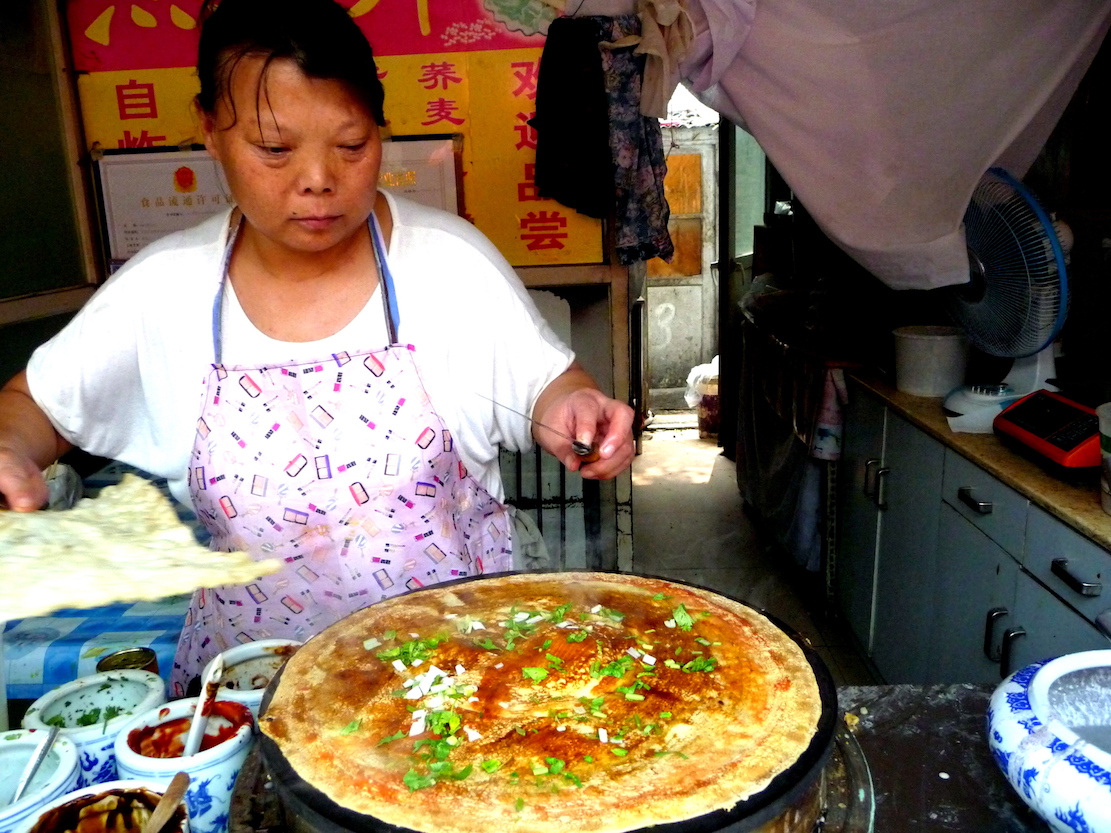
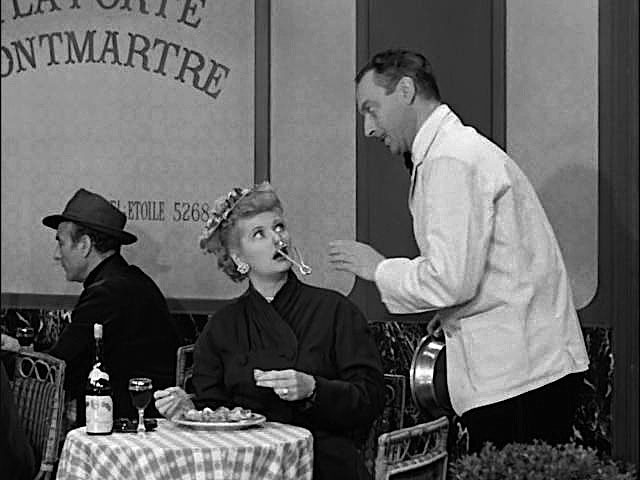 FOOD WRITING
101: TRY NOT TO STATE
FOOD WRITING
101: TRY NOT TO STATE
THE OBVIOUS OR INSULT YOUR
READERS' INTELLIGENCE
“French
fare can sound intimidating to order or seem overly
fancy with dishes such as escargot or foie gras, but
fear not. French food also consists of recognizable
dishes like pan-seared salmon, French onion soup and
freshly baked pastries including croissants.”—Agnes
Poliquin, “Las Vegas Dining Agenda,” Eater.com.
(2/14/17)
Sponsored
by Banfi Vintners
SPRING IS HERE AND
SO ARE WONDERFUL CHILEAN WINES
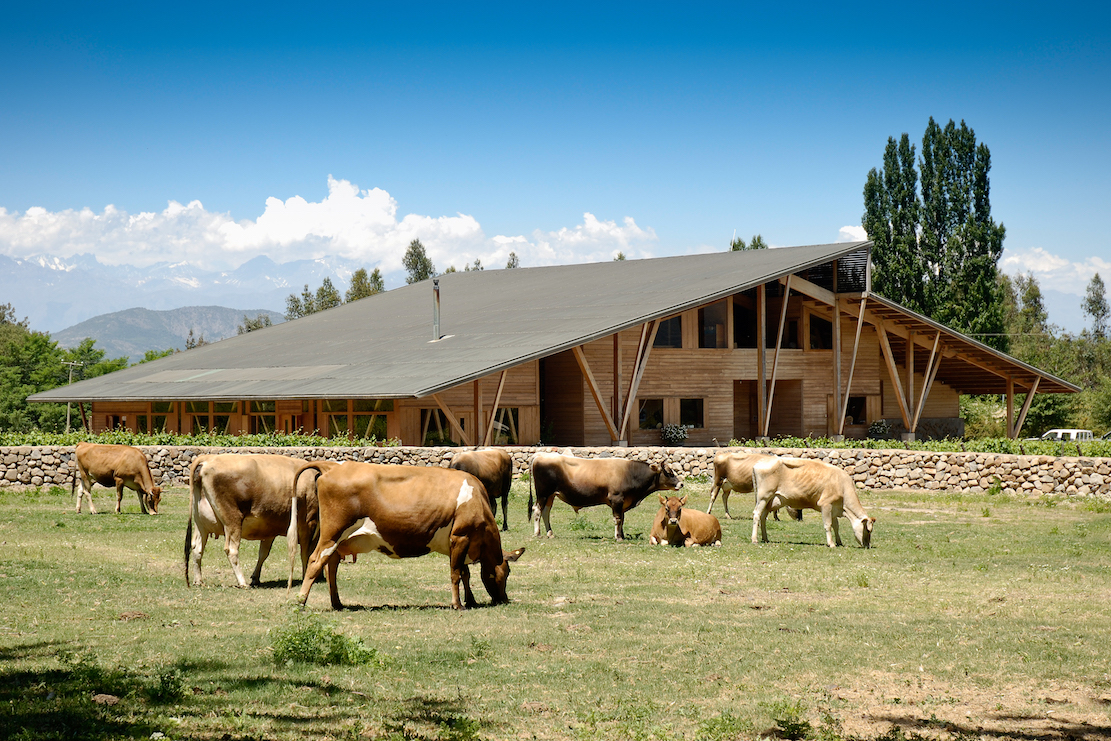 As Spring finally kicks into
gear, we are reminded of the fragility of Mother Earth
and her bounty. As an importer representing
several family wine makers from around the globe, I
often like to point out that all the wines that we
represent are green, some of them greener than
others. The greenest of all are classified as
Biodynamic or certified Organic. One of the most
interesting selections of eco-balanced, organic and
biodynamic wines comes to us from Chile and the
vineyards of Emiliana.
As Spring finally kicks into
gear, we are reminded of the fragility of Mother Earth
and her bounty. As an importer representing
several family wine makers from around the globe, I
often like to point out that all the wines that we
represent are green, some of them greener than
others. The greenest of all are classified as
Biodynamic or certified Organic. One of the most
interesting selections of eco-balanced, organic and
biodynamic wines comes to us from Chile and the
vineyards of Emiliana.
Emiliana was founded by
our friends, the Guilisasti family, who have a long
and proud history of winemaking with their Concha y
Toro brand. Three decades ago, well ahead of the
curve that has made organic wines all the rage today,
they set up dedicated and, most important for organic
farming, isolated vineyards for this type of
agriculture. Many may picture the small farmer
as being the most “organic,” but in the reality of our
wine world, sometimes it takes the “big guys” to act
as a locomotive to get a movement such as this on
track.
Organic farming is a form of
agriculture which avoids or largely excludes the use
of synthetic fertilizers and pesticides, plant growth
regulators, and livestock feed additives.
Organic farmers
rely on crop rotation, crop residues, animal
manures--including llamas--and mechanical cultivation
to maintain soils productivity
and health, to supply plant nutrients, and to control
weeds, insects and other pests. To call a wine
organic in the US, government regulation says that it
must be produced from 95% organically grown
ingredients with no added sulfites. If you add
sulfites in the relatively minimal amount of 100 parts
per million, you can only say that the wine is “made
from organically grown grapes.” Now, not to go
into a chemistry lesson, but it is virtually
impossible to make a wine without that modest dose of
sulfites, at least if you want to drink it beyond ten
feet of the cellar it was made in and wish it to
survive any moderate amount of aging.
productivity
and health, to supply plant nutrients, and to control
weeds, insects and other pests. To call a wine
organic in the US, government regulation says that it
must be produced from 95% organically grown
ingredients with no added sulfites. If you add
sulfites in the relatively minimal amount of 100 parts
per million, you can only say that the wine is “made
from organically grown grapes.” Now, not to go
into a chemistry lesson, but it is virtually
impossible to make a wine without that modest dose of
sulfites, at least if you want to drink it beyond ten
feet of the cellar it was made in and wish it to
survive any moderate amount of aging.
Biodynamic farming adheres
to the same principles, but takes it one step further
by relying on the cycles of the moon and the sun to
dictate much of what is done in the field, and uses
animal treatments such as compost teas, horns buried
with fertilizer, deer bladders, etc., to
treat the soil. It may sound a little hocus
pocus, but in reality it is very comparable to
homeopathic medicine, using the body’s (in this case,
the earth’s) own energy to heal
itself.
Emiliana has four distinct
collections of lovingly crafted organic wine now
available in the US – the base line of Natura, the
next step up in Novas, a stand-alone wine in Coyam,
and the ne-plus-ultra of bio-dynamic wines, Ge.
One taste of any of these and you too may find
yourself turning green – not with envy, but for a
newfound love of organic winemaking!
Recommended – green wines for Spring:
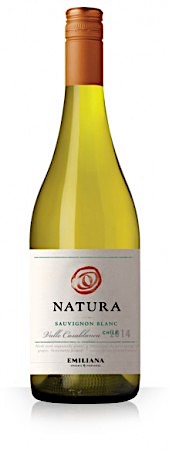 Natura
Chardonnay In the cool coastal Pacific climate of the
Casablanca Valley, organically grown grapes are hand
picked during the last week of March, and vinified in
stainless steel tanks, free of the domineering
influence of oak. On the nose, tantalizing
citrus aromas of grapefruit and lime blend with notes
of pineapple, all of which reappear on the palate and
finish with balance thanks to the wine’s freshness and
natural acidity. Delicious with spring salads
and seafood dishes.
Natura
Chardonnay In the cool coastal Pacific climate of the
Casablanca Valley, organically grown grapes are hand
picked during the last week of March, and vinified in
stainless steel tanks, free of the domineering
influence of oak. On the nose, tantalizing
citrus aromas of grapefruit and lime blend with notes
of pineapple, all of which reappear on the palate and
finish with balance thanks to the wine’s freshness and
natural acidity. Delicious with spring salads
and seafood dishes.
Natura Carmenere – From the rustic
isolation of the Colchagua Valley, this intense and
voluptuous offers aromas of cherries, chocolate and
spice, coming together in ramped up volume on the
palate with soft, round tannins and firm,
well-balanced structure. Great balance between
fruit and oak, with a long, juicy finish.
Novas Sauvignon Blanc Gran
Reserva – Hailing
from the San Antonio Valley’s thin rocky and clay
soils, the organic grapes for this wine are harvested
by hand in March and undergo fermentation in stainless
steel to preserve their bright fruit character.
Herbal notes mixed with citrus and soft floral hints
fill the bouquet; the taste is medium bodied with
grapefruit flavors joined by a delicate acidity and a
touch of minerality.
Novas Pinot Noir Gran
Reserva – The
grapes for this wine are grown in the cool, coastal
Casablanca Valley’s permeable sandy loam soils, and
harvested by hand. After a cold soak on the
skins, the wine is aged for 8 months in French oak
barrels to add character, depth and roundness.
Bright ruby red in color with attractive aromas
of berries, strawberries and notes of spice and cocoa,
this wine bursts with fruit flavor, layered with
earthiness. Delicious with white meats, light sauces,
full flavored fish and shellfish, cured ham and sushi.
Coyam – A blend dominated by Syrah
with nearly equal parts of Carmenere and Merlot
balanced by “soupcons” of Cabernet  Sauvignon, Mourvedre and
Petit Verdot, from the Colchagua Valley estate called
Los Robles – Spanish for the oaks, called
“Coyam” by the native Mapuche people in their own
language. Hand harvested certified biodynamic grapes
are naturally fermented in French oak barrels.
Coyam is largely unfiltered and aged for 13 months in
barrels. Aromas of ripe red and black fruits
integrate with notes of spice, earth and a hint of
vanilla bean. Elegant expressions of fruit are
delicately interwoven with oak, mineral and toffee.
Sauvignon, Mourvedre and
Petit Verdot, from the Colchagua Valley estate called
Los Robles – Spanish for the oaks, called
“Coyam” by the native Mapuche people in their own
language. Hand harvested certified biodynamic grapes
are naturally fermented in French oak barrels.
Coyam is largely unfiltered and aged for 13 months in
barrels. Aromas of ripe red and black fruits
integrate with notes of spice, earth and a hint of
vanilla bean. Elegant expressions of fruit are
delicately interwoven with oak, mineral and toffee.
Ge – Chile’s first certified
biodynamic wine, the name Ge is a nod to Geos, the
earthly environment pulling together all the elements
that surround us. Ge is a blend of nearly equal
parts of Syrah, Carmenere and Cabernet Sauvignon grown
in the deep soils of colluvial origin in the coastal
range, which lends mineral complexity. Naturally
fermented in oak barrels, Ge is deep plum red with
violet tones; it offers intense aromas of black fruits
and berries alongside mineral notes and a soft touch
of tobacco leaf. Generously fruity with cedar
notes, Ge is well balanced with tremendous volume,
well rounded tannins and a long finish.
For more information please visit http://www.banfiwines.com/winery/emiliana/
Any of John Mariani's books below may be ordered from amazon.com.
 The
Hound in Heaven (21st Century Lion Books)
is a novella, and for anyone who loves dogs,
Christmas, romance, inspiration, even the supernatural, I
hope you'll find this to be a treasured favorite.
The story concerns how, after a New England teacher,
his wife and their two daughters adopt a stray puppy found
in their barn in northern Maine, their lives seem full of
promise. But when tragedy strikes, their wonderful dog
Lazarus and the spirit of Christmas are the only things
that may bring his master back from the edge of
despair.
The
Hound in Heaven (21st Century Lion Books)
is a novella, and for anyone who loves dogs,
Christmas, romance, inspiration, even the supernatural, I
hope you'll find this to be a treasured favorite.
The story concerns how, after a New England teacher,
his wife and their two daughters adopt a stray puppy found
in their barn in northern Maine, their lives seem full of
promise. But when tragedy strikes, their wonderful dog
Lazarus and the spirit of Christmas are the only things
that may bring his master back from the edge of
despair. WATCH THE VIDEO!
“What a huge surprise turn this story took! I was completely stunned! I truly enjoyed this book and its message.” – Actress Ali MacGraw
“He had me at Page One. The amount of heart, human insight, soul searching, and deft literary strength that John Mariani pours into this airtight novella is vertigo-inducing. Perhaps ‘wow’ would be the best comment.” – James Dalessandro, author of Bohemian Heart and 1906.
“John Mariani’s Hound in Heaven starts with a well-painted portrayal of an American family, along with the requisite dog. A surprise event flips the action of the novel and captures us for a voyage leading to a hopeful and heart-warming message. A page turning, one sitting read, it’s the perfect antidote for the winter and promotion of holiday celebration.” – Ann Pearlman, author of The Christmas Cookie Club and A Gift for my Sister.
“John Mariani’s concise, achingly beautiful novella pulls a literary rabbit out of a hat – a mash-up of the cosmic and the intimate, the tragic and the heart-warming – a Christmas tale for all ages, and all faiths. Read it to your children, read it to yourself… but read it. Early and often. Highly recommended.” – Jay Bonansinga, New York Times bestselling author of Pinkerton’s War, The Sinking of The Eastland, and The Walking Dead: The Road To Woodbury.
“Amazing things happen when you open your heart to an animal. The Hound in Heaven delivers a powerful story of healing that is forged in the spiritual relationship between a man and his best friend. The book brings a message of hope that can enrich our images of family, love, and loss.” – Dr. Barbara Royal, author of The Royal Treatment.
 |
The Encyclopedia of American Food and Drink by John F. Mariani (Bloomsbury USA, $35) Modesty forbids me to praise my own new book, but let me proudly say that it is an extensive revision of the 4th edition that appeared more than a decade ago, before locavores, molecular cuisine, modernist cuisine, the Food Network and so much more, now included. Word origins have been completely updated, as have per capita consumption and production stats. Most important, for the first time since publication in the 1980s, the book includes more than 100 biographies of Americans who have changed the way we cook, eat and drink -- from Fannie Farmer and Julia Child to Robert Mondavi and Thomas Keller. "This book is amazing! It has entries for everything from `abalone' to `zwieback,' plus more than 500 recipes for classic American dishes and drinks."--Devra First, The Boston Globe. "Much needed in any kitchen library."--Bon Appetit. |
"Eating Italian will never be the same after reading John Mariani's entertaining and savory gastronomical history of the cuisine of Italy and how it won over appetites worldwide. . . . This book is such a tasteful narrative that it will literally make you hungry for Italian food and arouse your appetite for gastronomical history."--Don Oldenburg, USA Today. "Italian
restaurants--some good, some glitzy--far
outnumber their French rivals. Many of
these establishments are zestfully described
in How Italian Food Conquered the World, an
entertaining and fact-filled chronicle by
food-and-wine correspondent John F.
Mariani."--Aram Bakshian Jr., Wall Street
Journal.
"Equal parts
history, sociology, gastronomy, and just
plain fun, How Italian Food Conquered the
World tells the captivating and delicious
story of the (let's face it) everybody's
favorite cuisine with clarity, verve and
more than one surprise."--Colman Andrews,
editorial director of The Daily
Meal.com. "A fantastic and fascinating
read, covering everything from the influence
of Venice's spice trade to the impact of
Italian immigrants in America and the
evolution of alta cucina. This book will
serve as a terrific resource to anyone
interested in the real story of Italian
food."--Mary Ann Esposito, host of PBS-TV's
Ciao
Italia. "John Mariani has written the
definitive history of how Italians won their
way into our hearts, minds, and
stomachs. It's a story of pleasure over
pomp and taste over technique."--Danny Meyer,
owner of NYC restaurants Union Square
Cafe, The Modern, and Maialino.
|
 |
 |
 |
 |
 |
 |
 |
 |
 Everett Potter's Travel Report:
Everett Potter's Travel Report: 
 Eating Las Vegas
JOHN CURTAS has been covering the Las Vegas
food and restaurant scene since 1995. He is
the co-author of EATING LAS VEGAS – The 50
Essential Restaurants (as well as
the author of the Eating Las Vegas web site: www.eatinglasvegas.
He can also be seen every Friday morning as
the “resident foodie” for Wake Up With the
Wagners on KSNV TV (NBC) Channel 3 in
Las Vegas.
Eating Las Vegas
JOHN CURTAS has been covering the Las Vegas
food and restaurant scene since 1995. He is
the co-author of EATING LAS VEGAS – The 50
Essential Restaurants (as well as
the author of the Eating Las Vegas web site: www.eatinglasvegas.
He can also be seen every Friday morning as
the “resident foodie” for Wake Up With the
Wagners on KSNV TV (NBC) Channel 3 in
Las Vegas.

MARIANI'S VIRTUAL GOURMET
NEWSLETTER is published weekly. Editor/Publisher: John
Mariani.
Editor: Walter Bagley. Contributing Writers: Christopher Mariani,
Robert Mariani, Misha Mariani, John A. Curtas, Geoff Kalish, Mort
Hochstein, and
Brian Freedman. Contributing Photographers: Galina
Dargery. Technical Advisor: Gerry McLoughlin.
To un-subscribe from this newsletter,click here.
© copyright John Mariani 2017

